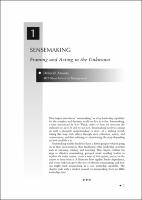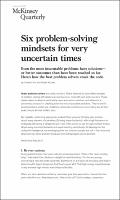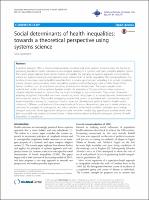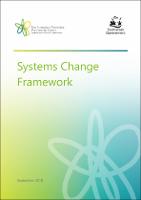Browsing by Title
Now showing items 235-254 of 299
-
Saving babies’ lives (SBL) – a programme to reduce neonatal mortality in rural Cambodia: study protocol for a stepped-wedge cluster-randomised trial
(2021-09-07)
Background: Neonatal mortality remains unacceptably high. Many studies successful at reducing neonatal mortality have failed to realise similar gains at scale. Effective implementation and scale-up of interventions designed to tackle neonatal mortality is a global health priority. Multifaceted programmes targeting the continuum of neonatal care, with sustainability and scalability built into the design, can provide practical insights to solve this challenge. Cambodia has amongst the highest neonatal mortality rates in South-East Asia, with rural ... -
Saving more lives on time: Strategic policy implementation and financial inclusion for safe abortion in Indonesia during COVID-19 and beyond
(2022-09-06)
Abortion is common in Indonesia, with 79% being unsafe. Unsafe abortion is one of the top five causes of maternal deaths globally. Meanwhile, in Indonesia, the maternal mortality rate (MMR) is still high, with up to 30% of it being related to unsafe abortion. In the COVID-19 pandemic, the number of unsafe abortions is expected to increase along with a 15–30% increase in unintended pregnancies. This will add to the number of maternal deaths on top of direct deaths caused by COVID-19. In Indonesia, access to safe abortion is still limited based on ... -
Self-assessment of attitudes towards conditions to provide safe abortion among new medical graduates in Thailand, 2018: an application of cross-sectional survey with factor analysis
(2021-07-21)
Background: Unsafe abortion is one of the major public health problems in Thailand. Although the penal code of Thailand and the Thai Medical Council permit doctors to perform safe abortion in certain conditions, little is known about the attitudes that new medical doctors have towards abortion. The objectives of this article are to explore the attitudes towards abortion in certain conditions among new medical graduates and to identify factors related to those attitudes. Methods: A cross-sectional survey was conducted in 2018 among 2017 medical ... -
The selfawareness questionaire
(2019-02) -
Sensemaking: framing and acting in the unknown
(2012)
This chapter introduces “sensemaking” as a key leadership capability for the complex and dynamic world we live in today. Sensemaking, a term introduced by Karl Weick, refers to how we structure the unknown so as to be able to act in it. Sensemaking involves coming up with a plausible understanding—a map—of a shifting world; testing this map with others through data collection, action, and conversation; and then refining, or abandoning, the map depending on how credible it is. Sensemaking enables leaders to have a better grasp of what is going ... -
Sexual and reproductive health literacy of school adolescents in Lao PDR
(2019-01-16)
Rationale: Adolescent pregnancy in Lao PDR is the highest in Southeast Asia. It leads to negative health and social consequences in young people. It is anticipated that this problem is partly caused by limited sexual and reproductive health literacy (SRHL), leading to poor sexual and reproductive health (SRH) decisions. Based on the concept of health literacy, SRHL goes beyond knowledge and behavior and is the self-perceived ability of an individual to access the needed information, understand the information, appraise and apply the information ... -
Singapore's migrant workers struggle to get paid
(CNN, 2018) -
Six problem-solving mindsets for very uncertain times
(McKinsey Quarterly, 2020-09) -
Social capital in the prevention and management of non-communicable diseases among migrants and refugees: a systematic review and meta-ethnography.
(2021-12-05)
Globally, the burden of non-communicable diseases (NCDs) falls disproportionately on underserved populations. Migrants and refugees are particularly vulnerable due to economic instability and systemic poverty. Despite the myriad of health risks faced by migrants and refugees, access to appropriate healthcare is hindered by structural, cultural and socioeconomic barriers. We conducted a systematic review and meta-ethnography to obtain critical insight into how the interplay of social capital and structural factors (eg, state policies and socioeconomic ... -
The social determinants of chronic disease management: perspectives of elderly patients with hypertension from low socio-economic background in Singapore
(2019-01-03)
Background: In Singapore, the burden of hypertension disproportionately falls on the elderly population of low socio-economic status. Despite availability of effective treatment, studies have shown high prevalence of sub-optimal blood pressure control in this group. Poor hypertension management can be attributed to a number of personal factors including awareness, management skills and overall adherence to treatment. However, these factors are also closely linked to a broader range of community and policy factors. This paper explores the perceived ... -
Social determinants of health inequalities: towards a theoretical perspective using systems science
(2015)
A systems approach offers a novel conceptualization to natural and social systems. In recent years, this has led to perceiving population health outcomes as an emergent property of a dynamic and open, complex adaptive system. The current paper explores these themes further and applies the principles of systems approach and complexity science (i.e. systems science) to conceptualize social determinants of health inequalities. The conceptualization can be done in two steps: viewing health inequalities from a systems approach and extending it to ... -
Socio-demographic and geographic disparities of population-level food insecurity during the COVID-19 pandemic in Thailand
(2023-01-13)
Introduction: This study investigated the prevalence of food insecurity, and the association between socio-demographic and geographic factors and food insecurity in Thailand during the COVID-19 pandemic. Methods: The study extracted data on 5,066 persons age 15 years or older from a nationally-representative sample survey of Thai households, conducted during June-December 2021. The respondents were asked about food insecurity, socio-demographic characteristics, debt, and role of the primary household food provider. Binary logistic regression ... -
Socioeconomic inequalities in effective service coverage for reproductive, maternal, newborn, and child health: a comparative analysis of 39 low-income and middle-income countries
(2021-09-07)
Background: Reducing socioeconomic inequalities in access to good quality health care is key for countries to achieve Universal Health Coverage. This study aims to assess socioeconomic inequalities in effective coverage of reproductive, maternal, newborn and child health (RMNCH) in low- and middle-income countries (LMICs). Methods: Using the most recent national health surveys from 39 LMICs (between 2014 and 2018), we calculated coverage indicators using effective coverage care cascade that consists of service contact, crude coverage, ... -
Stigma of mental illness and cultural factors in Pacific Rim region: a systematic review
(2021-01-07)
Background: Although cultural factors play a crucial role in experience of stigma, there is scant review on the impact and importance of culture on stigma of mental illness across Pacific Rim Region. This study aims to investigate: 1) the cultural factors related to stigmatizing beliefs about mental illness in Pacific Rim region, and 2) culture-specific measures and interventions on stigma of mental illness. Methods: A systematic search of papers was conducted in the MEDLINE, Embase, CINAHL, Web of Science, PsycINFO, Scopus, Cochrane Library ... -
Strengthening the migrant-friendliness of Thai health services through interpretation and cultural mediation: a system analysis
(2020-12-08)
Background: In addition to healthcare entitlements, ‘migrant-friendly health services’ in Thailand include interpretation and cultural mediation services which aim to reduce language and cultural barriers between health personnel and migrants. Although the Thai Government started implementing these services in 2003, challenges in providing them still remain. This study aims to analyse the health system functions which support the interpretation and cultural mediation services of migrant health worker (MHW) and migrant health volunteer (MHV) ... -
Strong structuration analysis of patterns of adherence to hypertension medication
(2022-05-18)
Achieving blood pressure control is among the highest priorities for reducing the burden of cardiovascular diseases globally. Control is poor in the Philippines, especially in socioeconomically marginalised communities. This paper explores long-term adherence to anti-hypertensive medication in these communities, identifying 4 distinct medication adherence patterns. We draw on Strong Structuration Theory to explore motivations of action for those who are consistently adherent, consistently non-adherent, and those who became more or less adherent ... -
System dynamics modelling of health workforce planning to address future challenges of Thailand’s Universal Health Coverage
(2021-03-10)
Background: System dynamics (SD) modelling can inform policy decisions under Thailand's Universal Health Coverage. We report on this thinking approach to Thailand's strategic health workforce planning for the next 20 years (2018–2037). Methods: A series of group model building (GMB) sessions involving 110 participants from multi-sectors of Thailand's health systems was conducted in 2017 and 2018. We facilitated policymakers, administrators, practitioners and other stakeholders to co-create a causal loop diagram (CLD) representing a shared ... -
A systematic review of factors influencing participation in two types of malaria prevention intervention in Southeast Asia
(2021-04-20)
Background: Multi-pronged malaria elimination strategies are increasingly being considered for accelerating efforts against malaria transmission in Southeast Asia. Two malaria prevention interventions used in in the region are insecticide-treated bed-nets (ITNs) and mass drug administration (MDA). Universal access to ITNs is recommended and high population coverage (e.g. above 80%) is needed during MDA initiatives to maximize the impact of these interventions. However, variability in ITN use and individual MDA participation exists. This systematic ... -
Systems Change Framework
(The Australian Prevention Partnership Centre and the Tasmanian Department of Health, 2018) -
Teaching the Social Determinants of Health: A Path to Equity or a Road to Nowhere?
Medical schools are increasingly called to include social responsibility in their mandates. As such, they are focusing their attention on the social determinants of health (SDOH) as key drivers in the health of the patients and communities they serve. However, underlying this emphasis on SDOH is the assumption that teaching medical students about SDOH will lead future physicians to take action to help achieve health equity. There is little evidence to support this belief. In many ways, the current approach to SDOH within medical ...




















